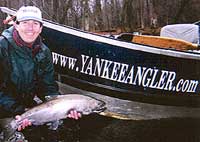The Perfect Drift
by Randy Jones 
Drift Fishing Correctly with Fly Rod: (Providing your rigging is correct)
Correct speed of drift
Imitating an egg-nymph dead drifting along the bottom at the same rate of speed as the water column is imperative to successfully hooking up. This is achieved by looking where your mono butt section enters the water. It should be moving slightly slower than the surface current. This matches the bottom current speed close enough. Making your offering look real enough to even the smartest fish.
Jim Rusher once told me that in the wintertime it is sometimes advantageous to slow your drift down even further. This allows the lethargic fish time to move slightly for what it thinks is an easy meal.
Correct depth of drift
When I first cast into a new piece of water my first question is: how deep? This determination is achieved by raising or lowering the rod tip until light ticking of weight on bottom rocks is felt. The next step for me is to look at the distance between the surface of the water and end of the fly line. (I prefer to run an 8-11ft. butt section of 8 lb. test straight mono for steelhead, so the fly line never touches the water on the drift.) By this distance between fly line and water I know exactly where it should be on each successive cast, which allows me to set up immediately for each additional cast to achieve the perfect drift. The next question I ask myself is: am I weighted correctly?
Visual and non-visual characteristics of line
When drift fishing correctly the line between tip of the rod and the weight should be a straight line. If you try to dead drift with a bow in your line, you not only create additional drag which speeds up your drift making your fly look unnatural but you also create a lot of unnecessary snags on the bottom. Without a straight line (slack) your weight is simply slogging along the bottom looking for the quickest and easiest rock to call home for good. A lot of the time if you have slack in your line you will not feel the ticking sensation due to the vibrations not being transferred up through the line. Remember: with line straight from tip of rod to weight you will be lightly tapping the tops of the rocks, cutting down on drag, giving it a more natural drift and getting hung-up on the bottom less.
Angle of rod tip to line
To achieve a maximum dead drift and cut down on snags the rod tip should be directly over the line. If the rod tip is in front of line then you will be prematurely initializing the swing. Also, if the weight runs into structure, you will be pulling it into it and creating a worse snag than if the rod tip was over the line and twitched directly up and over any obstruction.
Pre-setting and setting of hook
Whenever you set and find nothing there, don't return your rod to its original position unless you draw up the slack. If your rod is replaced to its original angle, you'll end up fishing with a bow (slack) in your line because when you set you brought your weight closer to you. Getting hung-up will normally follow.
Common problems
If you ever catch yourself bouncing you rod tip constantly on the drift (more than 3-6 inches), four things could be happening:
-
Too much weight. Solution - Lighten-up or you'll be getting hung-up all day. I keep 8 different sized bags of split shot with me to achieve the perfect drift, no matter where I'm fishing.
-
Slack (bow) line from tip of rod to weight. When bouncing the rod excessively you are simply picking the weight up and off a rock, dropping your tip back to its original position and letting the weight return to the snag-filled bottom below only to get caught up again. Solution - Return and re-read: Correct depth of drift; Characteristics of line from tip to weight; Pre-setting and setting of hook.
-
You are setting the hook on the subtle pauses and hesitations, instead of pre-setting with 3-6 inch twitch of the rod tip. Remember: if you do set the hook and come up empty then remove the slack by pulling additional line in.
-
You are obviously fishing in snag heaven, loaded with big rocks and boulders. Solution - keep fishing because these areas hold unpressured fish. In November the steelies love to hold in 3-5 feet of rippled, pocket water. Fast-moving water with big boulders is steelhead heaven. Normally these areas are not fished heavily by seasoned anglers because you will spend a fair potion of the day retying. Most guides avoid these areas like the plague. But sometimes the fishing can be "Outstanding".
Besides all the other pieces of the puzzle we have covered and will cover, hopefully these tips will help you all to be more in tune with your drift fishing. Putting all of this together consistently will put you into the 10% that catch 90% of the fish!
Happy Hookin!
Randy Jones

Randy Jones is a thoroughly proficient and professional full-time fly / spin fishing guide with 18+ years of fresh and saltwater experience. He has represented Orvis Corporation as a guide (18 years) and chief instructor of their 2-1/2 day Saltwater Fly Fishing schools. During the summer, Randy can be found guiding the Monomoy Island area (Cape Cod) where sight fishing on the flats for Trophy Striped Bass is his specialty. During the Fall, Winter and Spring Randy runs a drift boat and wade trips on the World Class Salmon River in upstate N.Y. for Steelhead, Coho, Browns, Atlantics and Kings. Visit his award winning web site at www.YankeeAngler.com.
Content © Randy Jones
Formatting © 2000 FishUSA.com
All Rights Reserved